Recent Mold Remediation Posts
That Works?! Why These Mold Prevention Tips Will Surprise You
9/5/2023 (Permalink)
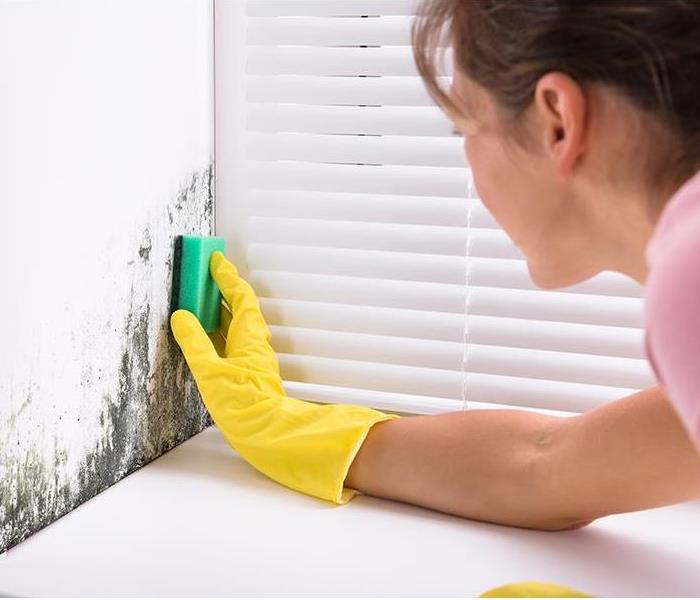 cleaning mold
cleaning mold
It’s an issue in more than 50% of homes in the U.S. It can cause health issues. If its presence is severe enough, it can cost you thousands of dollars in home renovations. Yes, we’re talking about mold. But these surprisingly simple tips can help you prevent mold from growing in your home or business.
- Ventilate to let air circulate. Temperature changes can cause moisture levels to fluctuate and water to condense on surfaces in your home. You can prevent this excessive moisture in your home with proper ventilation. Open windows to let air in and use ceiling fans to keep air circulating and stop mold from becoming an issue. Using ceiling fans or exhaust fans are another good way to promote air circulation in your home.
- Maintain proper indoor humidity levels. Mold needs moisture to grow, so if your home humidity level is too high it is a breeding ground for excessive mold growth. Ideally, the EPA recommends homes be between 30% and 50% humidity in order to prevent mold growth and maximize air quality. If your home humidity level is more than 60%, there’s a good chance that mold growth can happen.
- Keep gutters clean and monitor outdoor drainage. Preventing mold growth inside your home can actually start by preventing outside issues. Make sure your home’s landscaping is designed to prevent water from pooling around your home and leaking into your foundation. Dirty or clogged gutters can also lead to excess water draining into your home through your siding, so make sure to keep gutters clean and flowing properly.
- Clean up spills. It’s a simple step, but one that many people often ignore: When there’s a water spill in your home, mop it up. Also, watch for other instances of water such as leaving wet clothes piled on the floor, wet carpeting, or even wet umbrellas. Eventually these small situations can lead to unpleasant smells and mold growth in as little as two days.
- Don’t ignore water leaks. Your home’s plumbing can be a troublesome source for mold growth. At least once a month, check all of your pipes to make sure there are no leaks. You should also look underneath your sinks, behind toilets, and in your basement for any signs of water leaks. Over time and if left unchecked, water leaks can cause serious mold issues and potential property damage.
Mold Experts, Here for You 24/7
If mold or water damage becomes an issue in your home or business, our expert team is here for you any day and any time at 414-421-3500. At SERVPRO of Southeast Milwaukee County, Southeast Waukesha County, we have the training and equipment to combat mold issues and return your property back to its “Like it Never Even Happened” condition. Simply call or contact us online for more information about our offerings.
What Can You Do About Mold and Mildew?
11/10/2020 (Permalink)
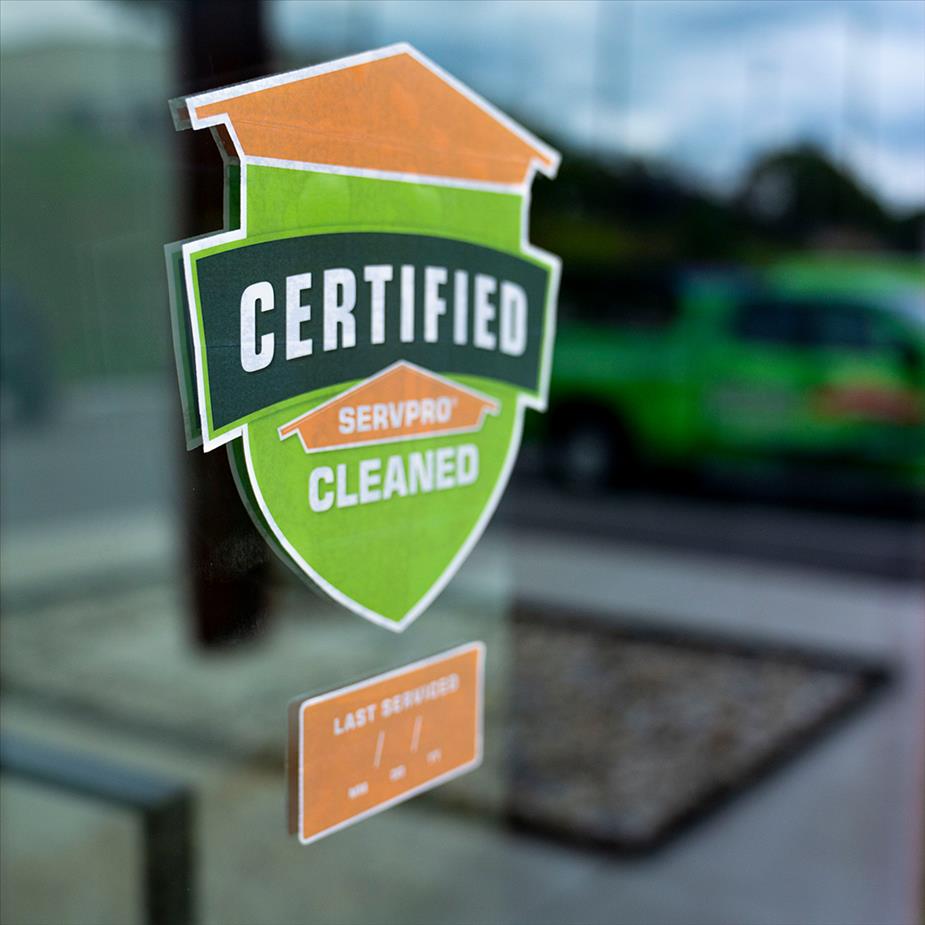 Certified: SERVPRO Cleaned window sticker
Certified: SERVPRO Cleaned window sticker
You can’t see them, even when magnified up to 400 times. Under normal conditions indoors, you inhale up to 10,000 of them per minute. But under excessively humid conditions, they can cause health effects to humans and animals…we’re talking about mold and mildew. How can you keep mold and mildew at bay to maximize indoor air quality in your home or business?
What’s the difference between mold and mildew?
Mildew is a surface fungi that grows in green-white colored patches (think long-forgotten leftovers in a refrigerator). Mildew grows on top of moist areas, and can easily be treated with a store-bought cleaner and scrub brush.
Mold is a different story. Once black or green patches of mold are detected, it means there is a larger infestation of this otherwise microscopic organism. Often you hear the term black mold, which can produce allergens and irritants in affected areas of buildings. Black mold is not toxic, but it can cause health effects. Because mold thrives in damp environments, water damage or excessive humidity must be addressed to prevent mold from regrowing.
How can I prevent indoor mold and mildew issues?
The most effective way to control mold and mildew indoors is to control your humidity levels. Ideally, an indoor humidity level of 30–50% will prevent mold and mildew growth, and promote the best possible indoor air quality. Water damage is another main source of mold growth. In fact, mold grows sin homes or businesses that have some sort of water damage within as little as 48 hours.
The EPA is a comprehensive source that offers are several ways you can prevent mold and mildew growth in your home. But for mold growth resulting from water damage, it’s best to consider hiring a professional to remediate mold and properly restore your property. In the meantime, there are mold damage emergency tips to practice before expert help arrives.
What’s the difference between mold removal and mold remediation?
Bottom line: Mold spores exist because they are a vital part of our ecosystem. But excessive indoor mold and mildew growth is not part of that eco-equation. This is an important point to note when companies guarantee that they “remove mold.” Microscopic mold spores are nearly everywhere, so removing them from inside a home or business is impossible.
Mold remediation, on the other hand, is the proper way that professionals eliminate visible mold growth and bring mold levels down to normal, healthy levels. With proper cleaning techniques, your home or business can be restored and refreshed for the long term.
Breathe Better Indoor Air with SERVPRO
Mold and mildew growth can happen year-round, so it’s good to know you can depend on our Southeast Milwaukee SERVPRO team 24/7. In fact, residents and businesses in your neighborhood rely on us for mold remediation, water damage restoration, fire restoration, and much more. Contact us for a complimentary consultation, or when you need us in an emergency.
Mold vs Mildew
10/30/2017 (Permalink)
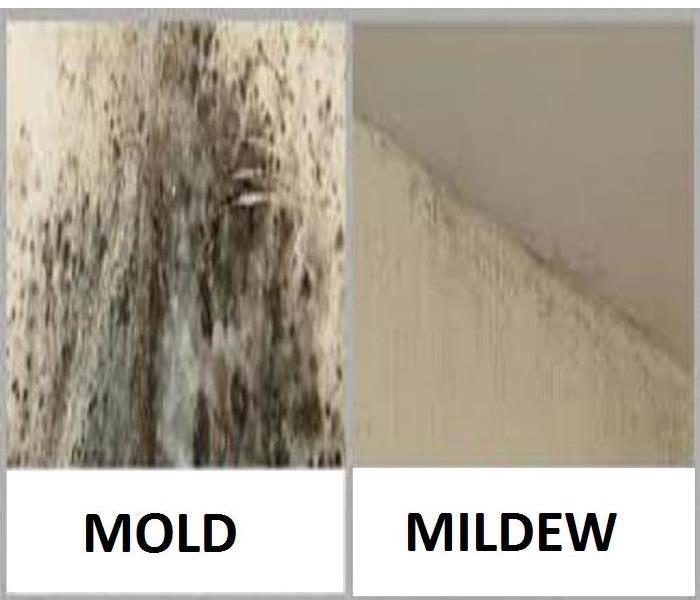 mold vs mildew
mold vs mildew
Most people lump mold and mildew together as the same thing. But these fungi do have several key difference that will be helpful to know when you encounter them.
Both mold and mildew are members of the fungi kingdom. They grow in moist or humid areas, like bathrooms and attics and oftentimes gives off a strong musty odor as they grow. Mold and mildew both produce and emit spores to reproduce and feed on organic materials.
Mildew is a surface fungi that can easily be identified as a patch of gray or even white fungus that is lying on the surface of a moist area.
Mildew is usually easily treated with a store bought cleaner, a scrubbing brush and some good old fashioned elbow grease.
Mildew has no known beneficial uses.
Mold, on the other hand, can be black or green and is often the result of a much larger infestation.
Some molds, like Penicillium, are used in the production of food and pharmaceutical drugs.
Molds are everywhere
10/27/2017 (Permalink)
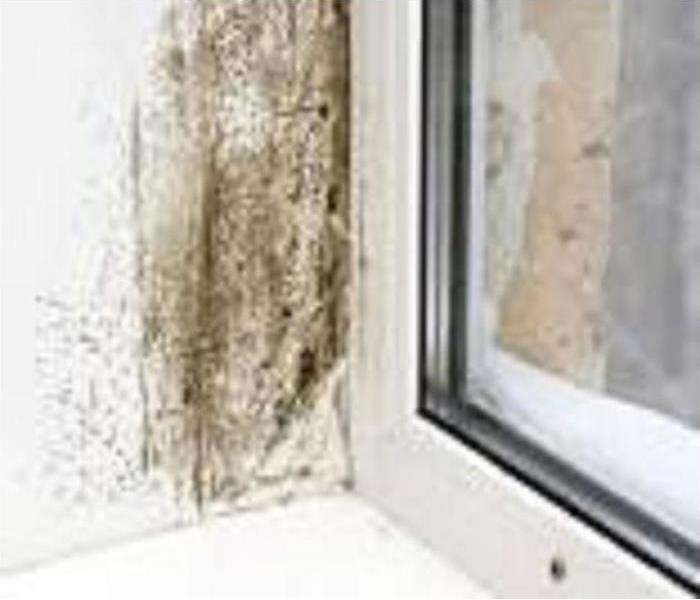 Mold growth
Mold growth
Molds are found everywhere, and can grow on almost any substance when moisture is present. They reproduce by spores, which are carried by air currents. When spores land on a moist surface suitable for life, they begin to grow.
Because common building materials are capable of sustaining mold growth and mold spores are ubiquitous mold growth in an indoor environment is typically related to water or moisture and may be caused by incomplete drying of flooring materials (such as concrete).
Flooding, leaky roofs, building maintenance or indoor plumbing problems can lead to interior mold growth. Water vapor commonly condenses on surfaces cooler than the moisture laden air, enabling mold to flourish. This moisture vapor passes through walls and ceilings, typically condensing during the winter in climates with a long heating season.
Significant mold growth requires moisture and food sources and a substrate capable of sustaining growth. Common building materials, such as plywood, drywall, furring strips, carpets and carpet padding are food for mold.
SERVPRO of Southeast Milwaukee County can remediate your mold. Just give us a call.
How do molds affect people?
9/22/2017 (Permalink)
Some people are more sensitive to molds that others. Those people who are sensitive to mold will have symptoms such as eye irritation, wheezing, skin irritations or nasal stuffiness. More severe reactions can include fever or shortness of breath. In isolated cases, people with chronic lung illnesses may develop mold infections in their lungs.
A 2004 study conducted by the Institute of Medicine found limited or suggestive evidence linking indoor mold exposure and respiratory illness in otherwise healthy children.
Here are some specific recommendations to help avoid excessive mold growth in your home:
- Keep humidity levels as low as you can - no higher than 50%.
- Use an air conditioner or a dehumidifier during humid months.
- Be sure your home has adequate ventilation, including exhaust fans.
- Add mold inhibitors to paints before application.
- Clean bathrooms with mold killing products
- Do not carpet bathrooms or basements
- Promptly remove or replace previously soaked carpets and upholstery.
Mold can begin to grow within 48 hours. So, time is important.
If the job is bigger than you want to handle, give us a call! SERVPRO of Southeast Milwaukee County is here to help.
Mold: From the Ordinary to the Unhealthy
9/5/2017 (Permalink)
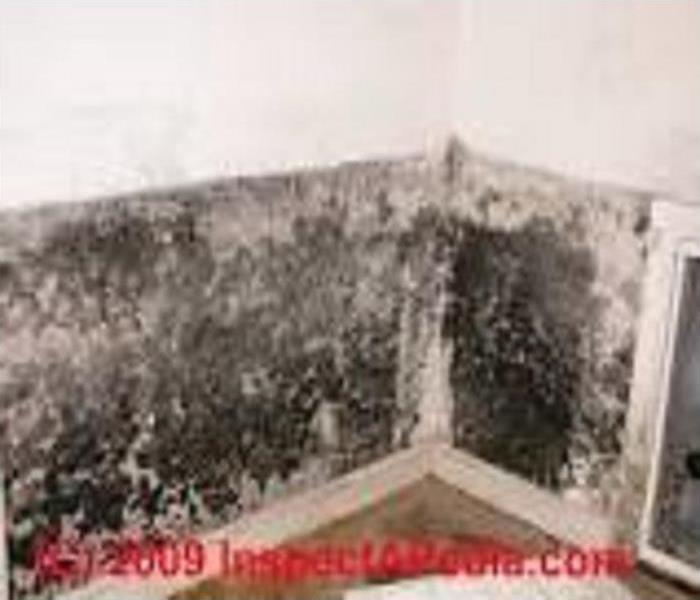 Example of black mold
Example of black mold
Fungi and mold naturally occur in our environment. In fact, over 100,000 kinds of fungi have been identified. Fungi produce some very useful results. Yeast is a type of fungi used in preparing breads, baked goods and other food products, including some alcoholic beverages. The unique flavor of blue cheese is a result of mold. An edible mushroom is simply a type of fungi, and lifesaving penicillin is a product of mold (Penicillin chrysogenum).
Even though some forms of mold can add value to our lives, other forms can be harmful. Excessive amounts of mold, different types of mold, and/or exposure to molds may present health concerns for some people.
Intrusion of water into your home or place of business can result in mold growth. Water intrusions can result from storm damage, plumbing or equipment failures, long-standing leaks and poor humidity control. When water intrusions are not addressed right away, the resulting damage can present increased risk of harmful mold growth. Some amount of mold spores are normally present in most environments. If the humidity and moisture levels in a water-damaged environment are not promptly returned to normal, mold spores may grow and multiply. Organic materials found inside a building, such as wood, paper, drywall and insulation, provide food sources for mold to flourish. Excessive mold growth can lead to indoor environmental condisitons that pose a heath threat.
Take Precautions
9/5/2017 (Permalink)
SERVPRO of Southeast Milwaukee County has a professional team that can handle water damages every day and know prompt action is required to prevent mold growth. Mold is more likely to spread when an environment has been subject to moisture for a long period of time. If your property has sustained a recent water damage, it is vital to remove excess water and dry the structure promptly. If these is an ongoing moisture problem in the building, it is important to be alert for:
- The presence of visible mold.
- Strong musty odors which may indicate mold is present.
- Any evidence of past moisture problems that might have caused undetected mold growth.
- Excessive humidity
These conditions may require the expertise of a qualified Indoor Air Quality/Environmental Professional to inspect the building for mold growth and water damage problems.
You have a smell...What could it be?
8/21/2017 (Permalink)
You only have one chance to make a first impression with visitors to your home or business. If you have a moist basement or even if you had water come through a door or window and it wasn't thoroughly and properly dried out, you could have mold. One indicator can be the smell, some people describe as "musty".
While molds are found naturally in the environment, an overabundance inside buildings is undesirable; some people can become ill. People most at risk are infants, children, pregnant women, elderly and people with compromised respiratory systems or weakened immune system.
Although experts disagree about the more controversial details of mold, they all agree that if you have excessive mold, it needs to be removed.
SERVPRO of Southeast Milwaukee County has the proper equipment and experience to take care of your mold problem - big or small. Just give us a call!




 24/7 Emergency Service
24/7 Emergency Service





